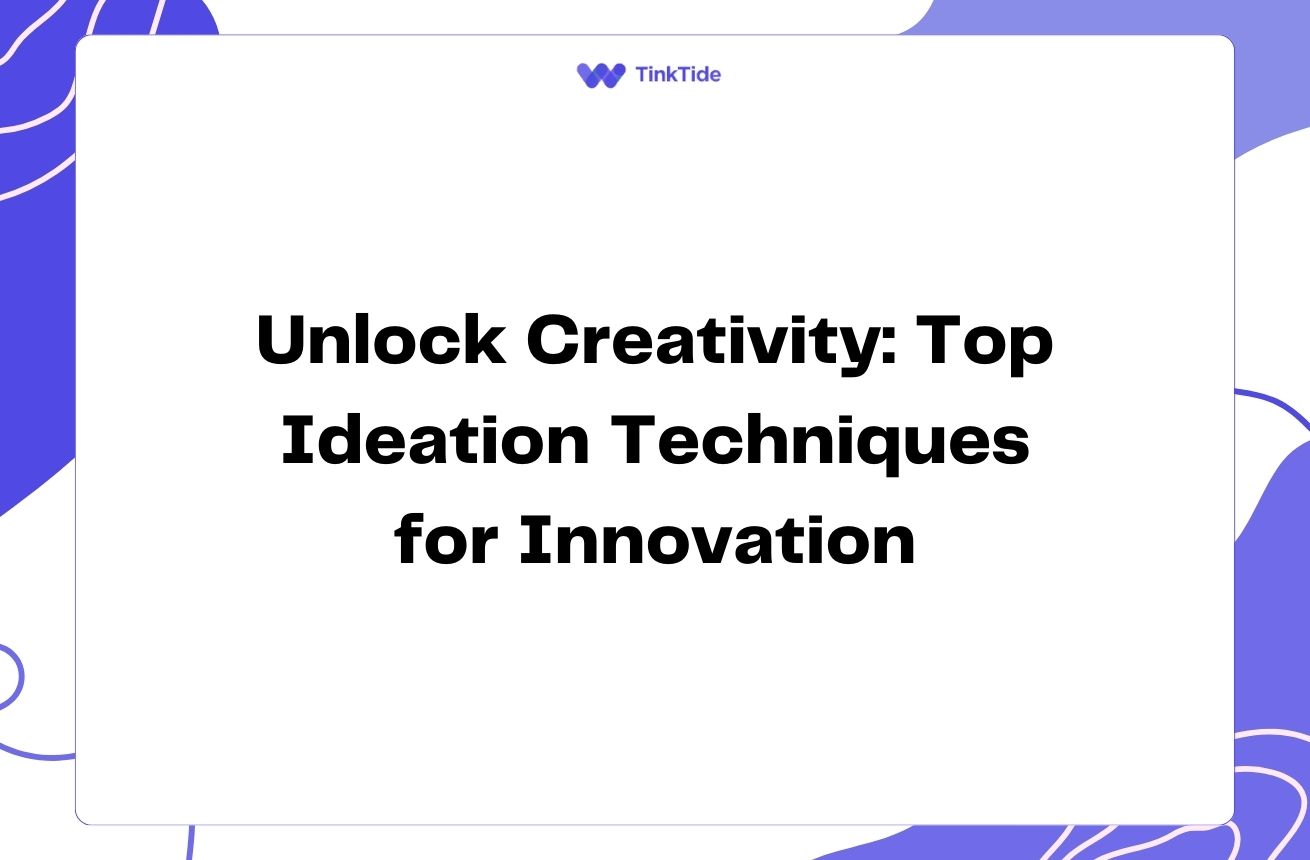Innovative Ideation Techniques for Fintech Breakthroughs
The Importance of Ideation in Fintech
In the rapidly evolving world of financial technology, innovative ideas are the lifeblood of success. Fintech companies need to constantly generate fresh concepts to stay ahead of the curve and meet the ever-changing needs of their customers. Effective ideation techniques can help you uncover groundbreaking solutions that revolutionize the financial sector.
The fintech industry faces unique challenges, such as regulatory compliance, security concerns, and the need for seamless integration with existing financial systems. These factors make ideation in fintech particularly complex, requiring a blend of creativity, technical knowledge, and industry insight.
By employing tailored ideation techniques, fintech companies can tap into their team's collective expertise and generate ideas that address specific pain points in the financial sector. This approach not only leads to more relevant and impactful solutions but also helps companies differentiate themselves in a crowded market.
Design Thinking for Fintech Innovation
Design thinking is a powerful ideation technique that can be particularly effective in the fintech sector. This human-centered approach focuses on understanding user needs and developing solutions that address those needs in innovative ways.
- Empathize: Conduct user research to understand the financial challenges and needs of your target audience.
- Define: Clearly articulate the problem you're trying to solve based on user insights.
- Ideate: Generate a wide range of potential solutions without judgment.
- Prototype: Create quick, low-fidelity prototypes of your most promising ideas.
- Test: Gather feedback from users and iterate on your prototypes.
By applying design thinking to fintech ideation, you can create solutions that not only solve technical problems but also resonate with users on an emotional level. This approach can lead to more intuitive and user-friendly financial products and services.
Trend-Driven Ideation
Staying abreast of the latest fintech trends is crucial for generating relevant and forward-thinking ideas. Trend-driven ideation involves identifying emerging technologies, market shifts, and changing consumer behaviors to inspire new solutions.
Start by regularly monitoring fintech news sources, attending industry conferences, and following thought leaders on social media. Create a trend wall or digital board where team members can share interesting developments they come across.
Once you've identified key trends, use them as prompts for brainstorming sessions. For example, if you notice a growing interest in decentralized finance (DeFi), you might explore how to incorporate blockchain technology into your existing products or develop entirely new DeFi solutions.
Remember to consider both short-term and long-term trends. While it's important to capitalize on current opportunities, anticipating future trends can help you stay ahead of the competition and develop truly innovative solutions.
Cross-Industry Pollination
Some of the most innovative fintech solutions come from applying ideas from other industries to financial problems. Cross-industry pollination involves looking outside the finance sector for inspiration and adapting successful concepts to fit fintech needs.
For example, you might explore how the gaming industry uses gamification to increase user engagement and apply similar techniques to personal finance apps. Or you could look at how e-commerce platforms personalize the shopping experience and adapt those strategies for wealth management services.
To facilitate cross-industry pollination, encourage your team to read widely and explore diverse fields. Organize field trips to companies in different sectors or invite guest speakers from various industries to share their insights and spark new ideas.
This approach can lead to truly innovative solutions that set your fintech company apart from competitors who are solely focused on traditional financial practices.
Regulatory-Inspired Innovation
While regulations are often seen as a constraint in the fintech industry, they can also be a source of innovation. Regulatory-inspired ideation involves viewing compliance requirements as opportunities rather than obstacles.
Start by thoroughly understanding the regulatory landscape in your target markets. Look for areas where compliance is particularly challenging or where regulations are evolving. These pain points can be fertile ground for innovative solutions.
For example, the introduction of open banking regulations in many countries has led to a wave of fintech innovations in areas like account aggregation and personalized financial advice. Similarly, stringent data protection laws have spurred the development of advanced encryption and security technologies.
By framing regulatory challenges as opportunities for innovation, you can develop solutions that not only comply with regulations but also provide unique value to your customers and potentially create new revenue streams.
Collaborative Ideation Techniques
Fintech solutions often require input from diverse stakeholders, including financial experts, technologists, designers, and regulatory specialists. Collaborative ideation techniques can help bring these different perspectives together to generate more comprehensive and viable ideas.
- Brainwriting: Participants write down ideas individually before sharing and building on each other's concepts.
- Mind mapping: Create visual representations of ideas and their connections to identify new opportunities.
- Role-playing: Team members assume different personas (e.g., customer, regulator, competitor) to explore ideas from various angles.
- Reverse thinking: Start with the worst possible solution and work backwards to uncover innovative approaches.
- Hackathons: Organize intense, time-limited events where cross-functional teams collaborate to develop prototypes of new fintech solutions.
These collaborative techniques not only generate a wider range of ideas but also foster a culture of innovation within your organization. By involving diverse team members in the ideation process, you can create a sense of ownership and excitement around new fintech solutions.
Data-Driven Ideation
In the fintech sector, data is a valuable asset that can fuel innovation. Data-driven ideation involves analyzing large datasets to identify patterns, trends, and unmet needs that can inspire new solutions.
Start by aggregating data from various sources, including customer behavior, market trends, and financial transactions. Use data visualization tools to make this information more accessible and easier to interpret.
Look for anomalies, correlations, or gaps in the data that might point to opportunities for innovation. For example, you might discover a particular demographic that's underserved by current financial products or identify common pain points in the customer journey.
Combine this data-driven approach with other ideation techniques to generate ideas that are both innovative and grounded in real-world insights. This can lead to fintech solutions that are more likely to succeed in the market and provide tangible value to users.
Address common questions
As you explore ideation techniques for the fintech sector, you may encounter some common questions. Here are answers to help guide your innovation process:
How often should we conduct ideation sessions?
The frequency of ideation sessions can vary depending on your company's needs and resources. However, it's generally recommended to have regular ideation sessions (e.g., monthly or quarterly) to maintain a steady flow of new ideas. Additionally, consider holding ad-hoc sessions when faced with specific challenges or opportunities.
How can we ensure our ideas are truly innovative and not just incremental improvements?
To generate truly innovative ideas, encourage your team to think beyond current paradigms. Use techniques like 'What if?' scenarios or 'Blue Sky' thinking to remove perceived constraints. Also, regularly expose your team to diverse perspectives and emerging technologies to spark unconventional thinking.
How do we balance innovation with regulatory compliance in fintech?
Involve regulatory experts early in the ideation process to ensure compliance is considered from the start. Use regulatory requirements as design constraints that can spark creative solutions. Additionally, stay informed about regulatory sandboxes and other initiatives that allow for controlled testing of innovative fintech solutions.
What's the best way to evaluate and prioritize fintech ideas?
Develop a structured evaluation framework that considers factors such as market potential, technical feasibility, regulatory compliance, and alignment with your company's strategy. Use techniques like weighted scoring or the ICE (Impact, Confidence, Ease) method to prioritize ideas objectively.
How can we foster a culture of continuous innovation in our fintech company?
Create an environment that encourages risk-taking and learning from failures. Implement an idea management system to capture and develop ideas from all employees. Recognize and reward innovative thinking, even if ideas don't make it to market. Regularly share success stories and lessons learned from innovation initiatives.
Provide additional resources
IDEO's Design Thinking for Educators Toolkit
A comprehensive guide to applying design thinking in various contexts, including fintech.
CB Insights Fintech Trends
Regular reports on emerging trends in the fintech industry to inspire ideation.
MIT Fintech Conference
Annual event showcasing cutting-edge fintech innovations and networking opportunities.
Fintech Innovation Lab
Program connecting fintech startups with established financial institutions to foster innovation.
World Economic Forum's Future of Financial Services
In-depth reports on the future of finance, providing valuable context for fintech ideation.
Summarize key takeaways
Effective ideation is crucial for developing cutting-edge fintech solutions. By employing techniques such as design thinking, trend-driven ideation, cross-industry pollination, and data-driven approaches, you can generate innovative ideas that address real user needs and market opportunities.
Remember that successful fintech innovation requires a balance of creativity, technical expertise, and regulatory awareness. Encourage collaboration among diverse team members and create an environment that fosters continuous innovation.
As you apply these ideation techniques, stay focused on creating solutions that not only leverage the latest technologies but also provide tangible value to users and address key challenges in the financial sector. With the right approach to ideation, your fintech company can develop groundbreaking solutions that shape the future of finance.
Supercharge Your Fintech Innovation
Ready to take your fintech ideation to the next level? Try our AI-powered innovation platform for free.
Start Your Free Trial

